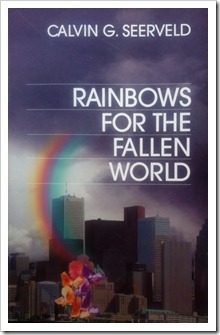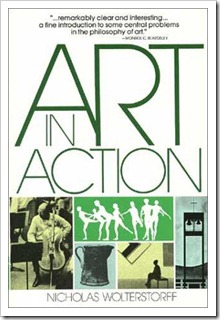 Cavin Seerveld, in his magnificent book, Rainbows for the Fallen World, makes the case that a Christian understanding of aesthetics must not succumb to the heresy of Plato's theory of “Forms.” where the non-material abstract idea of “beauty” is the higher, idealistic spiritual reality while the material world is somehow inferior.
Cavin Seerveld, in his magnificent book, Rainbows for the Fallen World, makes the case that a Christian understanding of aesthetics must not succumb to the heresy of Plato's theory of “Forms.” where the non-material abstract idea of “beauty” is the higher, idealistic spiritual reality while the material world is somehow inferior. When we talk about art, we are talking about real, physical cultural artifacts – created by and for human beings in the real world, and they are aesthetically important not because they point to some non-material idea but because they are, in fact, material. “Poets are not sorcerers; musicians are not progeny of the legendary Orpheus and his ‘divine’ song. Artistic composition and performance is simply and thoroughly human, no matter how unusual it may seem to the workaday beholder.” (p. 26)
 As Nicholas Wolterstorff states,
As Nicholas Wolterstorff states, “Characteristic of many religions and philosophies, characteristic of Christianity at many points throughout history, is a devaluation of the physical side of God’s creation, a devaluation just because of its physicality.” (Art in Action: Toward a Christian Aesthetic (Grand Rapids, MI: Eerdmans, 1980), p. 69).Wolterstorff itemizes several ways that the church has devalued the material creation, from those who hold that “spiritual values” are somehow superior to “material values,” to those who long for a future ideal nonphysical heavenly existence because they believe that a disembodied existence would somehow be superior to our earthly one.
“Every such form of devaluation flies in the face of God’s affirmation of His creation. The sheer physicality or materiality of something is never a legitimate ground for assigning to it a lower value in our lives.” (p. 69)Human beings, in Wolterstorff’s words, are “earthlings among earthlings” –
“Earthly existence is one of God’s favors to us. When the Christian affirms the goodness of physical creation, he is not just praising its magnificence. He is saying that the physical creation is good for human beings. It serves human fulfillment. Earth is man’s home, the world his dwelling place.” (p. 72)Human beings, however, are unique among the earthlings. What makes humans “uniquely unique” from the rest of God’s unique creatures is that God has given humanity a vocation and a purpose that is ours and ours alone. In Genesis, we read that God created humanity in the divine image and likeness:
Then God said, “Let us make mankind in our image, in our likeness, so that they may rule over the fish in the sea and the birds in the sky, over the livestock and all the wild animals, and over all the creatures that move along the ground.”God, the creator of all things, created humanity as one of the earthlings, but this earthling is created in the image of God – which is tied directly with the calling on them to “be fruitful and increase in number, to fill the earth, and subdue it, to rule over the rest of creation as God’s “vice-regents.”
So God created mankind in his own image,
in the image of God he created them;
male and female he created them.
God blessed them and said to them, “Be fruitful and increase in number; fill the earth and subdue it. Rule over the fish in the sea and the birds in the sky and over every living creature that moves on the ground.” (Genesis 1:26-28, NIV)
Genesis 2:15 gives us further insight into the vocation of humanity: “The Lord God took the man and put him into the garden of Eden to cultivate it and keep it.” (NASB)
The task of creating art, then, is yet one of many different manifestations of the human vocation of dominion and cultivation of God’s good creation. Art is one of the ways we can fulfill the creation mandate for humanity to take the raw resources of his good creation and to make something of it. Wolterstorff explains:
“It is not difficult to see how man’s vocation of master, of subduer, of humanizer of the world, of one who imposes order for the sake of benefitting mankind or honoring God, applies to the artist.” (p. 77)Calvin Seerveld helps us understand this even further:
“Art is work, hard, bodily work that can legitimately be a man or woman’s vocation. We have to get past the idea inherited from pagan Greek society (and often compounded by pietism) that poetry takes less of a man’s energy and presence than work with the hands, or that dance is by definition more sensuous and useless than architecturally planning a barn or singing in the church choir. Art is always the act of a whole man or woman, and no matter what form it takes—colored shapes, pulsing tones, rhymed words, stylized gesture—if it be honestly done, the art embodies heart, soul, mind and strength of the artist as he or she responds knowingly to the world of God around him.” (Rainbows, p. 27)Seerveld cautions us to not place too much emphasis on art as “beauty,” but rather to think of art as simply another type of vocational work. It is special only in that it has the ability to create metaphor, to work as parable so that we can understand things from a different vantage point. “Art calls to our attention in capital, cursive letters, as it were, what usually flits by in reality as fine print.” (p. 27)
Art is a part of experiencing God’s good life aesthetically. Seerveld identifies the aesthetic life as “the ordinary human activity to be humored and to be merry, to indulge imagining things and to be playful.” (p. 49) Art is the result of humans using their imaginations for human flourishing.
In the New Dictionary of Theology, Seerveld states in his article on “Imagination in Theology,” that “human imagination is the source of metaphorical knowledge and the playfulness so important to anyone’s style of life. Imagination is meant to be an elementary, important, residual moment in everything God’s adopted children do.” (p. 331)
Earthlings enjoying being creative in the material world – this is the calling of the aesthetic life.

No comments:
Post a Comment